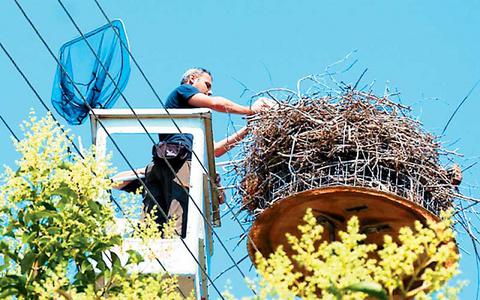Picture: www.ethnos.gr
Hundreds of white storks that are currently nesting in northern Greece have received Greek "passports". At least 190 young storks have been ringed in the National Park of Eastern Macedonia-Thrace, from Nea Karvali, Kavala, to Maroneia in the Rodopi regional unit, as well as a dozen others in the Delta of Evros.

Storks build their nests in high places in order to avoid dangers for newly hatched birds. Scientists needed a crane in order to ring the birds. What impressed them, and in particular representative of the Hellenic Bird Ringing Centre Eva Stetz, is the fact that this year has been particularly prolific. The mild winter and even milder spring, as well as abundant food found by storks in river basins facilitated the survival of a large number of newly hatched birds. Thus, although usually up to 3 newly hatched birds survive in a family, nests with 6 nestlings have been found in Vistonida, a fact which is very rare in Europe, and the offspring in the majority of nests numbers 4-5 nestlings.

A good year
"This has been a very good year for the reproduction of storks. In the spring, when storks came, they found abundant food and a large percentage of them survived - both adults and newly hatched birds," said guide in the National Park Vassilis Terzis. Eva Stetz coordinated the bird ringing operation providing technical expertise. ELSA rings were also used, in cooperation with the Delta Nestos Ismarida Vistonida Management Body.
Within four days, 6 villages in the general area of the National Park with 250 recorded nests were covered - Vafika, Genisea, Mangana (Xanthi), Pontolivado, Agiasma and Eratino, (Kavala), where 59 stork nests were checked and a total of 190 newly hatched storks were ringed. In a similar operation in the Delta of Evros, 29 newly hatched storks from 9 different nests were ringed around Poros, in collaboration with WWF-Dadias.

Storks come to Greece every spring and prefer the region of Northern Greece, although they can be seen throughout the country. It is estimated that about 600,000 of them come every year and spend the summer in the country, and in the autumn, they enter Turkey through Maritsa, then, through Asia Minor and Cyprus, they reach Africa, where they spend the winter in Sub-Saharan Africa.
Birds fly in the day and spend the night near water basins. They always fly in flocks. Adults fly first and last and young birds fly in the middle of the flock. Storks nest in high locations near settlements, and, unlike black storks that prefer wooded areas, white ones are very sociable. Their nests are made of tree branches and grass and have a diameter of 70-80 cm and are typically on roofs, chimneys, towers and minarets, or on large trees – generally, in locations that provide visibility. The Greek word "pelargos" (meaning stork) comes from "pelos" (black) and "argos" (white) and is associated with the black and white colouring of the bird.